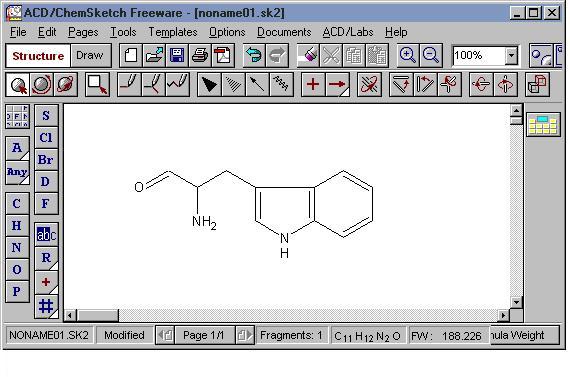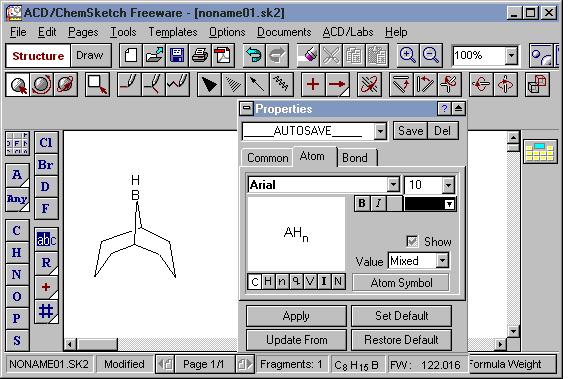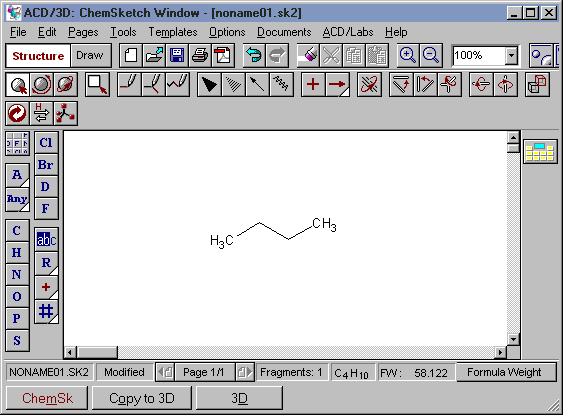draw a 3d structure of ethane
| | |
 | Chemic Structure |
| | | | |
Drawing Structures with ChemSketch
Information technology is amazing that ChemSketch is freeware because it is a quite powerful chemical construction drawing programme. One of its few drawbacks is that it is somewhat complicated to learn. However, if you accept any experience with drawing programs and then some aspects of it should be easier for y'all to learn.

Introduction
- Help | Help Topics | Contents tab | ChemSketch | Structure Mode | Construction Fashion screen Click through (!) these choices. Finally, you'll come across an interactive screen for Structure mode. Whenever you click on some part of the screen moving picture, you lot go help on that detail part. Keep the Help window open up while you lot learn. Y'all tin get the same interactive help for Drawing mode.
- Set General Preferences [ Options | Preferences ]
Modes
Chemsketch has ii modes: Structure and Draw. At that place are similarities and differences between them. More often than not, the Construction fashion generates structural parts of the file such as atoms and bonds and the Draw way allows yous to enhance them with arrows, boxes, and non-structure drawings. In both modes, there are drop downward dialog boxes and panels in which you make stylistic choices among unlike fonts, line widths, etc.
As you explore the toolbar buttons, bespeak to a button and in a moment a tool tip volition announced. This is one of the best ways to larn the tools buttons and their functions.
When you are using Help, open up the window on Mouse Commands. Each tool seems to behave slightly differently depending on whether y'all single or double-click, drag, etc. It is expert to be enlightened of the possibilities.
Tools
The 2 images below bear witness the Construction and Drawing Modes windows. In addition to the buttons in both modes, there are tool panels that apply formatting to your structure and drawing. Access the panels from the Tools carte du jour in both modes.
Tools | Construction Properties in Structure mode
The Structure Properties panel is open up. The panel can be moved anywhere, on or off the main window. The two most usually used tabs are "Common" and "Atom".

Tools | Panels in Cartoon Style
The panels that are open in the Describe Mode pertain mostly to text formatting (Font, Pen, Paragraph) and drawing (Arrow, Fill).

I. Chemical Structures
Cartoon structures -- The all-time way to learn how to draw with ChemSketch is to kickoff copying examples you lot see in books. There are some suggestions below you can copy for practice.
Use the Clean Structure tool to fix your cartoon (or sometimes it messes information technology up). There are multiple levels of "undo".
II. Drawing Tools and Objects
Drawing -- Some of the tools here are more obvious in how they are used, merely they are also of less chemical importance. Again, do copying examples.
Y'all'll find that your drawings are much easier to manipulate if y'all learn about Grouping and Ungrouping objects in Draw mode.
III. Templates
A swell aid and a stiff feature of ChemSketch are the Templates, that contain pre-drawn structures and figures. Admission the diverse templates from the driblet-down menu or from the tool bars at the top and right side of the Structure Style window.
The Table of Radicals contains the commonly drawn monocyclic rings and modest substituent and functional groups besides as amino acids. The Template Window and Organizer is an extensive collection of structures and drawings organized by type, such as sugars, steroids, etc. When you open the Template Window, there is a carte of collections on the left, simply clicking on the drop-down box will reveal many more than. You lot tin can choose your own short-cutting menu in the Organizer.
Open up the Templates Window and the Organizer to see what is bachelor. Y'all might start past exploring and checking these topics in the Template Window:
- orbitals;
- reaction symbols (including electrons);
- non-bonding and bonding electron pairs (Lewis structures)
- stereo templates;
- monocyclic alkanes;
- rings; and
- lab figures.
Make certain you find the little icon that indicates more than one page for many of these templates.
Four. Actress Features
Check out these Tools :
- Check tautomeric forms
- Generate proper name from structure
- Mass spec scissors
- Summate properties
- Search PubChem and eMolecules
Five. Saving Files equally Images
Importing and Exporting-- ChemSketch tin can open ( Import ) files in the Window Metafiles (wmf) format, as well every bit two others you'll go familiar with, the MDL .mol files used by DS Visualizer and the ChemDraw .chm files. ChemSketch can save ( Consign ) to these same formats every bit well equally to bmp and gif files. When you export to gif format, for example, from a ChemSketch document that has multiple pages, merely the page on view (or the selected portion) is saved as a graphic. Each page in CS must be saved separately.
Yous can copy a structure (and other objects) and paste it in some other application such equally Word or Excel. (What is the difference between the ways in which a structure and text are edited in Word after pasting?)
If you copy the epitome to Paint, or other graphics program, you can then salvage the file in the .gif format.
You tin re-create from other applications and paste into ChemSketch.
If you desire to open the three-D file in another molecular viewer, relieve the file every bit an MDL .mol file.
6. Embedding ChemSketch drawings in Windows applications
MS Office 2007 does not support OLE with ChemSketch to the same extent it does amid the Office applications (read the Object Linking and Embedding certificate). The terminal section of the documentincludes instructions on embedding ChemSketch drawings into Office 2007 apps. OLE is the next topic in the course.
ChemSketch Practice
1. Reproduce the structures shown in the Practice pages linked below. Drawing each of the practice structures volition help y'all learn some of the features of ChemSketch, e.k. drawing rings from the template menu, changing atom symbols, drawing carbon chains, etc. If you need to know how to practise something, open Help .
Practice page 1
Practice page two
Practice page 3
Do page 4
2. Many times you lot volition have to aggrandize a collapsed structural formula and show the right sterochemistry and geometry. This would exist a good time to review hybridization, geometry, bond angles , not-bonding electrons, formal charges, etc.
Hither are a few e xamples, with answers.
- Show an expanded zig-zag structure for northward-butane.
- Draw a structure for acetaldehyde in its most stable conformation (C-H eclipsing C=O). Show the localized p orbitals of the carbonyl grouping.
- Expand all the structures for the reaction And thenii + PClfive --> SOCl2 + POCl
Exist sure to testify the right geometry and not-bonding electrons (except for Cl) for each.
iii. Read the OLE and OLE Limitations documents mentioned above, after they have been assigned in class.
Select a ChemSketch object in the ChemSketch window. Copy information technology. Embed it into a Word page using Paste and so Paste Special... . Double-click the object. Is there any departure betwixt the two methods? Tin you Link the ChemSketch object?
Choose Insert | Object in Word. Choose Create New ACD ChemSketch object. Draw an object and end embedding in Word. What do you practise if y'all choose Create From File ? Tin you Link the file?
iv. Insert an equation into a ChemSketch certificate using Equation Editor.
5. Can y'all embed a Word certificate within a ChemSketch document? An Excel spreadsheet? If you lot tin can embed these objects, and you desire to edit them, do you lot need to be in the Construction or Depict modes, or either?
SMILES Structure Notation
Simplified Yardolecular Input Line Due eastntry Specification
http://world wide web.daylight.com/smiles/
SMILES is widely used as a general-purpose chemic nomenclature and data exchange format. The "character string" (the sequence of ASCII characters) represents a structrual model of a molecule. The string can be read by both humans and computers -- computers cannot typically read the 2- and three-dimensional structures generated by chemists.
Atoms
An individual chemical element is represented by a standard atomic symbol. It is required to be nowadays for each atom, except Hydrogen.
Elements and charged species are written within brackets.
examples:
[B] chemical element boron
[OH3+] hydronium ion
Elements in the post-obit "organic subset" typically take well-defined valences and may be written without brackets if the number of attached hydrogens conforms to the lowest normal valence consistent with explicit bonds. This subset, and their lowest normal valences, are:
B(three), C(4), N(iii,five), O(2), P(three,v), Southward(2,4,6), F(1), Cl(1), Br(1), I(i).
examples:
C marsh gas
N ammonia
Bonds
Single, double and triple bonds are represented by the symbols `-', `=' and `#', respectively. Alternatively, sp2-hybridized atoms may be represented in lower example. Unmarried bonds may exist omitted. If an cantlet is enclosed in brackets, all explicit Hydrogens must exist shown, as in the final example for ethane, below.
examples:
CC ethane
or
C-C
or
[CH3]-[CH3]
C=CC=C butadiene
or
cccc
CC#C propyne
Branches
Branches are specified by enclosing them in parentheses, and can be nested or stacked. The connexion to a parenthesized branch is to the left.
CC(C)C(=O)OC methyl isobutyrate
CCN(CC)CC triethylamine
Rings
examples:
C1CCCC1 cyclopentane
CC1CCC1 methylcyclobutane
c1ccccc1 benzene
Geometric Isomerism
examples:
F/C=C/F trans-1,2-difluoroethene
or
F\C=C\F
F\C=C/F cis-i,2-difluoroethene
or
F/C=C\F
SSMILES is an extremely simplified subset of SMILES used for expressing "normal" organic chemicals, i.e., neutral molecules with atoms at their normal organic valences. In that location is no demand for brackets, charges, aromatic specifications, etc. In fact the rules for the language are basically:
- Atoms are represented past diminutive symbols
- Double bonds are `=', triple bonds are `#'
- Branching is indicated by parentheses
- Ring closures are indicated past pairs of matching digits.
Which is pretty much what you encounter above.
Practice with piece of cake structures by cartoon them in ChemSketch and and so generating the SMILES annotation.
Here are a few examples.
ChemSketch 3D
ChemSketch is not only a molecular drawing plan, it is also a molecular visualization program. You can toggle back and along between the 2 programs.
I. To switch to the 3D window from the ChemSketch window:
- click the [3D] button at the bottom of the window, or
- describe a construction and click the [Copy to 3D] push at the lesser of the window, or
- if you lot don't see either of the 3D buttons, choose ACD/Labs | 3D Viewer from the menu bar.

A expert procedure for visualizing a molecule in 3D while preserving your drawing in the sketch pad is to first describe the molecule in Construction fashion, then press the [Copy to 3D] push. The view switches to 3D and the molecule appears in the window. It is still a second object, withal. From the 3D carte, choose Tools | 3D Optimization or click the 3D Optimization tool button.

In the case shown here for butane, the program adds the hydrogens and adjusts the bail angles. If you rotate the molecule, you tin can run into the anti staggered organization of the C-H bonds. The program has adjusted the geometry of the second sketch to the everyman energy molecular conformation (anti staggered).
Practice: Place a cyclohexane chair construction from the Templates window into the ChemSketch window. Echo the process described for butane, higher up. Be sure to rotate the optimized cyclohexane structure in the 3D window. What conformation is this?
Review the conformational analysis of alkanes (dihedral angle; staggered/eclipsed; anti/gauche) and cyclohexane (chair conformations, axial/equatorial bonds).
You tin can 3D-optimize your drawing in the sketch window before copying to 3D. However, you lot lose your original drawing in the sketch pad. Brand a copy before optimizing, and optimize only i of the structures.
Two. 3D Display
The molecular paradigm can exist rendered in line, stick, ball & stick, or spacefill modes. Toggle among them by right-clicking, or by pressing one of the toolbar buttons or cull View on the menu bar.
To rotate the molecule, hold down the left mouse button and elevate the molecule around the x, y, and z axes. To more precisely position the molecule effectually the x and y axes, press the up/down/left/right arrow keys.
III. Measurements
You can measure bail lengths, bond angles, and torsion angles for whatever molecule.
Click one of the measurement tool buttons. And so select the correct number of atoms in the molecule (length - 2; bail angle - 3; torsion angle - 4). A pop-up window shows the measurement.
Confirm the guess bond angles from the hybridization predictions in the Practice Bug posed to a higher place.
IV. Saving Files equally Images
You lot can re-create the 3D paradigm and Paste or Paste Special into some other Windows awarding. The background color is too copied and so you might want to change it from the default black to white. (You lot could also paste the image in Paint and change the groundwork there.)
If you paste it to Paint, or other graphics program, save the bitmap as a .jpg image. Y'all can then utilize the image in a web page.
Answers
1. Utilise the continuous chain tool and the "C" atom push to draw a zig-zag with 4 carbons. Then choose Tools | Add Explicit Hydrogens to sprout hydrogens at each of the carbons (or on selected carbons).
Use the stereobond tools. Use the "Lasso" tool to move the C's and H's around and so they look like they are in the front and back of the zig-zag. All the carbons are sp3-hybridized, tetrahedral geometry, ~109 deg. bond angles.

two. Draw acetaldehyde. Brand stereobonds. Add non-bonding electrons ( Template | Organizer | Reaction symbols). Press ^Chiliad to group the electrons with the molecule. Add together orbitals ( Template | Organizer | Orbitals ). In Draw mode, utilize text tool to add together C and O atom labels and use the line tool to add bonds. Group all segments. The carbonyl carbon is sp2-hybridized, trigonal planar geometry, ~120 deg. bail angles. The methyl carbon is sp3-hybridized, tetrahedral geometry, ~109 deg. bond angles.

three. Notice particularly the effect of the non-bonding pair of electrons on the geometry of the sulfur dioxide molecule (compare with linear CO2; the carbon is sp-hybridized, linear geometry, 180 deg. bond angle). What geometry is exhibited past PCl5? Review VSEPR theory for atoms with five or 6 unmarried bonds.

simmonsoppithatione.blogspot.com
Source: https://mason.gmu.edu/~sslayden/Chem350/manual/structure.htm
Post a Comment for "draw a 3d structure of ethane"